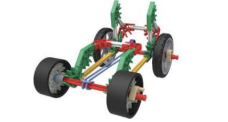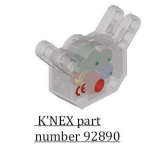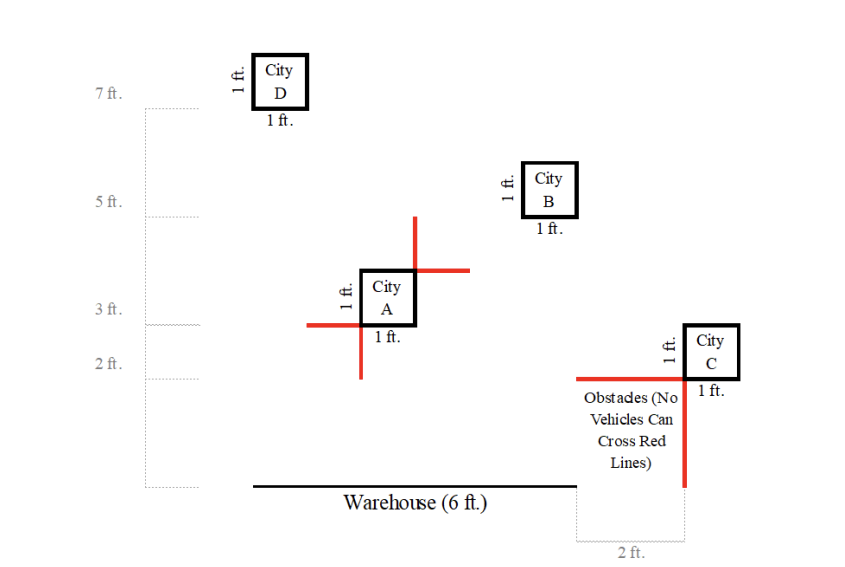Transportation Challenge

Student teams will compete with K’NEX vehicles that they bring and submit to the judges
on E-Day.
Vehicles will be powered by a single “Micro Power Spring Motor” available in the K’NEX Forces, Energy
& Motion set. See the Materials section below for more information.
- Teams will submit their vehicles during competition timeslots at the University of Memphis.
- Vehicles will be submitted unassembled with all parts contained in a zip-lock bag.
- The bag will be labeled with the submitting organization’s name and with the names
of the team
members. - Each team will represent their organization and will consist of four or fewer team
members.
Organizations may have up to three teams entering the competition.
2024 Competition Description:
The design goal is to develop a delivery vehicle to achieve the highest income by
delivering packages to
designated destinations identified as cities A, B, C, and D. Each of the cities will
be located in a different
area of the delivery zone (shown below). The vehicle design should allow for the transportation
of packages
between cities. An additional feature in the judging of the vehicle design will be
the speed of construction
of the vehicle on competition day.
The design goals should be:
- the ability to construct the vehicle quickly
- the ability to operate the vehicle so that profits are maximized.
More detailed rules for this competition are described in the sections below. Please
see the figure below for
the exact layout of the Delivery Zone on the day of the competition (drawn to scale).
The cities, warehouse,
and obstacle will be indicated by tape on a surface floor.
Materials:
Vehicles must be constructed from materials contained in standard K’NEX kits.
The motive force for the vehicles will be provided by a single micro power
spring motor as shown above. A penny will be used to represent a ‘package’
for the competition. You must bring the pennies you plan to use in your
delivery mission with you on the day of the competition. The pennies used
during the competition MUST be loose and not attached to each other.
During the competition, the pennies will be dropped off at the ‘cities.’
Therefore, ensure that you have enough pennies. The only other materials
that may be used are Styrofoam or plastic cups that can be used to hold the
packages in the vehicle.


Total Score for Transportation Challenge:
The total score for this competition is composed of two parts:
- Build time as described in Competition Rules 1 and 2.
- Profit developed during the delivery mission. The profit is determined by:
Profit = (# Packages delivered to City A)*$25 + (# Packages delivered to City B)*$50
+ (#
Packages delivered to City C)*$150 + (# Packages delivered to City D) *75 – (# of
refuels)*$200 –
(# of repairs)*$500
The formula for computing the total score is as follows:
![]()
Competition Rules:
- At registration, you will participate in a timed build phase. All the members of the
team may
participate in the building of the vehicle. Illustrations and drawings may be used during the
construction phase but no photos or other instructions that were not drawn by team members may
be used. - Each team will be assigned a judge to act as a timekeeper for their team. The official
time is the
time as decided by the assigned judge. The longest build time will be 15 minutes. Any time beyond
this will not be penalized. - Once a vehicle is declared completed, it may not be altered in any way, or else it
will be charged a
“repair” fee (of $500, see profit equation). Any time after the build phase is complete that a
vehicle is touched (except for “refueling” and picking up/dropping off packages) a repair fee
will be charged. - The vehicle must be constructed so that it is able to transport packages by placing
them in the cup
that is to be attached or supported by the vehicle. The cup or container may not be larger than 2” in
diameter and 3” in height. Teams must provide their own cup or container. If packages fall off the
vehicle, a repair fee will be charged. Packages can be picked up or dropped off by hand while in
the warehouse or in any of the cities. - After the build phase, the delivery phase will begin. All delivery runs will start
in the “warehouse”.
Teams will have 4 minutes to deliver as many packages to the three cities as possible. Teams may
choose to visit the cities in any sequence they choose. Teams do not have to visit all the cities, but
they are not allowed to exit and “reenter” a city without first returning to the warehouse. - During operation, the team may choose how many packages to transport and to which
city they
will deliver their packages. Once a delivery has been made to a city, the team may return their
vehicle to the warehouse square to pick up more packages or attempt to make another delivery to a
different city. Packages can only be picked up by the vehicle at the warehouse. A successful
delivery occurs when at least one of the vehicle’s tires has crossed the city boundary, at which point
packages can be dropped off. - You incur a fuel cost every time you must wind your vehicle. The charge is $200. This
includes starting from the warehouse for any delivery and any time that the vehicle must be
restarted during a delivery. Repair charges are incurred any time the vehicle is touched (except when picking up/dropping off packages or refueling).


